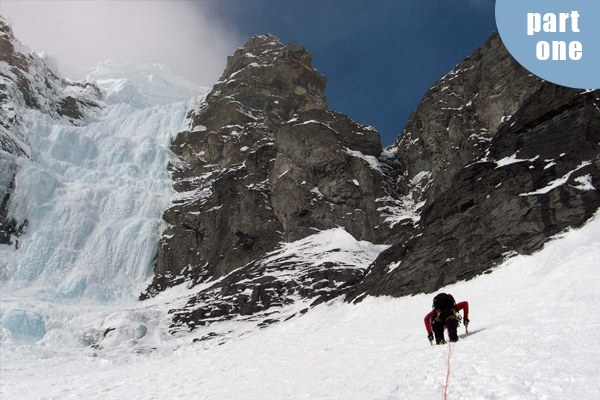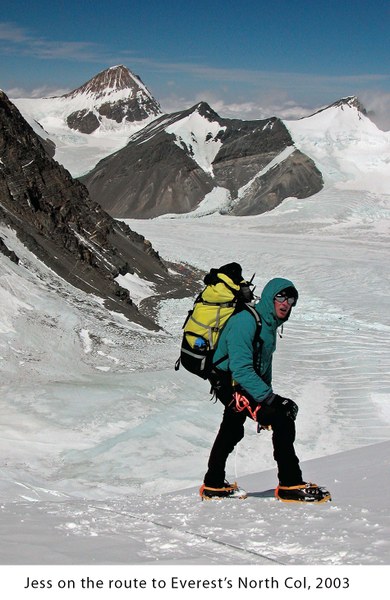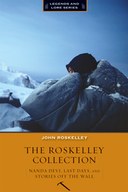
SLIPSTREAM, part 1
By John Roskelley
Excerpted from The Roskelley Collection, in memory of Jess Roskelley. (See Part 2 and Part 3)
Sunday, April 26, 2009
“Jess, you’ve got to move faster,” I hollered, then added, “Or we’re going to die right here.”
Jess didn’t flinch or even acknowledge my sense of urgency—he’s used to my impatience—but my reference to pending disaster brought instant response. His head swung around and his eyes caught mine as he glanced briefly down from his delicate vertical perch above me, as if to confirm “death” was there. He reracked the uncooperative ice screw he was trying to set into the pocketed ice without success, squarely faced the near-vertical ice, and rhythmically began swinging ice tools and planting the front points of his crampons. He was soon out of sight, but the inch-by-inch movement of the rope through my frozen gloves, and fresh snow and tool-displaced ice debris pummeling me from above, were enough proof that he was still climbing.
I settled into the belay, changing my pogo-leg stance frequently while dodging fist-size and larger ice meteors funneling onto me from above. Spindrift avalanches cascaded down the waterfall to my belay, but I was attached to the wall by two belay screws, so the cascades of snow were more of an annoyance than a real threat to my safety. What did frighten me, though, was my uncontrollable, hypothermic shivering, brought on by clothes soaked in climbing-induced sweat, a plunging temperature, interminable inaction, and too few calories. Of course, being sixty-years-old didn’t help either. Having leaned toward over confidence or underestimation of the route, we weren’t prepared for a night out in stormy conditions. With daylight fading and, so far, not a ledge in sight, a nasty bivouac looked inevitable. “We’ve lost control,” I thought to myself after a violent shiver. “Joyce is going to be just pissed.”

Thursday, April 23, 2009
“Look, I’ve told you repeatedly, I want to do the climb,” I said, “but conditions have to be perfect.”
“I only have next weekend,” my son, Jess, argued.
“We can’t jump on a climb like Slipstream just because it’s the only weekend you have,” I replied. “Climbers take years waiting for the right conditions on some climbs. You hedge your bet; check the weather; ask the rangers about the cornice and avalanche conditions; sharpen your tools. Life isn’t all about Slipstream.”
“I don’t have years,” he shot back. “I’ll call the rangers this afternoon and get the latest information. Will you go if the weather forecast is good?”
“I’ll go,” I said, “but this is the last time. I’m tired of wasting money driving to hell-and-gone, and taking four days of my life every spring to sit underneath that ugly thing.”
Slipstream, in Canada’s Columbia Icefields, had been an obsession of Jess’s for years. After he became the youngest American to summit Everest in 2003 at age twenty, he began to look for a follow-up success—a tall order, given all the publicity he’d received after climbing the highest peak on Earth. Up to this point, due to repeated episodes of bad climber’s karma, a second Cinderella story hadn’t emerged. Jess was eager to test his mettle on a known Canadian test piece, and Slipstream was his target.
Jess was not alone in harboring an obsession about a specific route or peak. Most climbers fixate on a boogeyman route at least once or twice in their careers. I’ve had my share of them, and still do. After I read famed French guide Lionel Terray’s book Borders of the Impossible in my youth, the West Ridge of Makalu—a route arrow-like in its 8000-foot rise to the 27,800-foot mountain, the fifth highest in the world—dominated my thoughts of mountaineering prizes for years. The black-and-white photo of that “pillar” was my lodestone as I climbed harder and more fascinating routes throughout the world. None stood the test of my imagination as did Makalu. Finally, in the pre-monsoon season of 1980, I realized my dream of climbing “le Pillar Ouest,” as the French called the most spectacular ridge in the Himalayas, when four of us from Spokane, Washington, made the first American ascent of Makalu and the second overall ascent of this magnificent route on Makalu without bottled oxygen or Sherpa support above base camp.
Nevertheless, climbing obsessions often go unrealized, as the twists and turns of life and our own multitude of passions throw many roadblocks in our path. Many a great endeavor has fallen prey to yard work, the kids’ soccer weekend, the social calendar, or, heaven forbid, another sport activity. As we get further into our lives, the burdens of life multiply like excess weight, slicing and dicing time, a precious commodity we have so little of, especially that which is free. Jess’s obsessions were trivial burdens compared to those of some climbers, and I could only wish for such minor problems.
When he showed me a photo sent to his cell phone of Slipstream, taken the day before our intended departure by a Canadian park ranger, that familiar spark of desire fired up in my chest—not as powerful as in my heyday, but enough to bring a slight drool to the corner of my mouth and a twitch to my left eye. The climbing bug was back.
“Did the ranger say anything about the weather?” I asked.
“The weather is going to be mixed sun and cloud, with periodic snowfall,” Jess replied. “I think we should give it a shot.”
Sitting in Spokane in shorts and T-shirt, contemplating “mixed sun and cloud” didn’t seem so bad, but that same weather at the Columbia Icefields in late April would require insulated underwear and down coats. That’s why the area is called an icefield.
“I’ll go, but on one condition,” I said. “If I don’t feel good about the avalanche conditions or the weather, we turn around and come home. Deal?”
“Deal,” he replied.
Sunday, April 26, 2009
I checked my watch. The fifteen minutes of extra rest I’d given myself as a treat had turned into thirty, and it was now 4:30 am. I sat up with my sleeping bag under my arms, opened the vestibule zip to the tent, and glanced out. There was a faint orange hue on the eastern horizon, but directly above was an azure-colored sky filled with brilliant diamonds—a perfect morning. The day before had been “mixed sun and cloud,” as predicted by the weather service, and snow squalls had spat on us most of the afternoon, always preceded by gusty winds in camp. If the pattern persisted as predicted, we would lose the clear skies to billowy cloud and snow squalls sometime in the afternoon.
By 6:00 am we were climbing the low-angled toe of the glacier, the path to Slipstream’s water ice. Tracks we had meticulously placed the afternoon before to make our morning climb more efficient were filled in, buried by wind-blown spindrift. I reached the end of our tracks from the previous day below the concrete-hard glacial ice where the first crevasses split the slope, and then traded trail-breaking duty with Jess. He traversed back and forth in the early morning light, avoiding the multitude of open crevasses on the easy-angled slope. Below an overhanging icefall, he traversed a hundred yards across Slipstream’s avalanche-prone debris gully to Mount Snowdome’s northeast rock ridge of layered and shattered dolomite.
Safety is relative when attempting alpine walls, but the edge of the rock and the towering ridge above us provided a bit of relief from the deep, sugar-like snow of the gully, poised to bury unwary climbers. We were vigilant but not overly concerned about the avalanche conditions because, other than on a few low-angled slopes, the snow seemed stable. Then again, the guidebook we had referenced, Waterfall Ice: Climbs in the Canadian Rockies, by Joe Josephson, did what all guidebooks seem to do—pass the fear of the previous parties on to the next via carefully crafted warnings. One such warning found a seedbed in my mind and grew like a weed as the day progressed: “Don’t underestimate this route—it is a very serious undertaking—as the number of lives lost on this route testifies.”
“We’ve got to move a bit faster,” I said. “That storm is coming in and we don’t want to get caught out tonight.”
I’d never heard of any deaths on the route, although I have to admit that I don’t keep up with that sort of thing. In fact, I had gotten the impression from Jess that Slipstream had become a “trade route” of sorts and that climbers were ascending it quite frequently, although when pressed for details, he dodged the question with time-honored romanticism.
On the other hand, my brother-in-law, Bob Loomis, a peer-acknowledged expert on all matter of climbing, was not so sure Slipstream was a casual undertaking. During a drive that winter to climb a partially frozen, two- hundred-foot column of cauliflower-like tiers with a connecting structure of narrow pillars—a waterfall more water than ice—Bob seemed perplexed at Jess’s casual approach to such a big wall.
“From everything I’ve read and heard,” he said between sips of green tea, “Slipstream in poor conditions can defeat even the best of teams. Even though [Mark] Twight flashed the route years ago, it’s my understanding Slipstream doesn’t get climbed very often.”
Knowing Jess’s optimism concerning everything Slipstream, I leaned heavily on Bob’s assessment and mentally prepared for an icy battle on a difficult, ogre-like climb. (Three months after our climb of Slipstream, the body of William Holland of Gorham, Maine, was found just a few hundred yards from our campsite. He and his partner had reached the summit of Mount Snowdome via Slipstream in 1989, but on their descent a cornice collapsed and Holland fell to his death. His body was not found until two hikers spotted his yellow jacket at the toe of the glacier twenty-one years later.)
The early morning sun peeked over Kitchener’s east ridge and caught us resting at the rock wall. Jess and I, warm from our effort, removed clothing layers, munched on energy bars, and hydrated. While Jess finished stowing his jacket, I led the ever-steepening snow slope, hugging the rock wall and assorted outcrops for security. After several hundred feet, I gave the unenviable duty of punching through knee-deep snow to Jess, who seemed invigorated with each plunge of his ax and each foot of altitude gained. We were soon at the first waterfall pitch.
The first pitch was mine. According to the guidebook, the 160-foot, water-ice 4 (WI 4) section was “the crux.” Not so. Just a glance at the route from the highway belied this first pitch’s importance in comparison to the many broad, multi-tiered, turquoise-blue frozen waterfalls cascading from below the summit to midway on the face. Feeling strong and confident, I led the pitch quickly and it disappeared beneath us in a heartbeat.
For the next one thousand feet, the route was a mixture of short vertical steps of water ice broken by two-hundred-foot pitches of low-angle, avalanche-prone snow slope. (Hmm, I thought, so the guidebook was right about the avalanche danger.) Protection was limited; we scolded ourselves for failing to bring a picket for the deep snow and a small selection of Lost Arrow pitons, as rock outcrops in the snowfield were prevalent. For safety, we placed our belays as near to the outcrops as our two-hundred- foot length of rope would allow.
By noon we were more than midway up the route. After leading a long, low-angled section of rounded ice bulges and snow slope, Jess found a solid stance a few feet below a vertical dolomite wall that framed the right side of the first of four difficult waterfall pitches protecting the upper route. Snow squalls were drifting into the valley and clouds smothered the peaks around us, indicating a predicted change in the weather.
Within a few minutes, I was at Jess’s side. We took a moment to wolf down an energy bar and quench our thirst before I attacked the next pitch, a calf-cramping 170 feet of eighty-degree water ice. Upon reaching the end of the rope, I placed several ice pitons for the belay on the right-hand side of the falls. Jess followed the pitch quickly, but not before my sweat-soaked clothes and the storm-cooled air left me chilled and shivering.
“We’ve got to move a bit faster,” I said. “That storm is coming in and we don’t want to get caught out tonight.”
Jess grabbed the remainder of the ice screws hanging from my harness and began the first of two low-angled pitches to the next vertical waterfall. After he ran a full rope length up the ever-steepening snow slope, I took a short pitch of mixed rock and ice and reached the bottom of three rope lengths of varied and sustained ice climbing.
“We better eat something here,” Jess said. “It doesn’t look like we’re going to get a good place up above.”
We drank Gatorade and downed a protein bar each before Jess racked his harness with ice screws and runners and began climbing the almost vertical pitch. Ice chunks ranging from finger-size fragments to dinner plates rained down upon me. My stance was limited to a square foot, and even though the belay seemed protected by the rock wall, the lay of the waterfall and Jess’s route focused the debris on top of me as if I were a magnet for ice. The ice debris, plus numerous spindrift avalanches down the route from the worsening weather, left me shivering uncontrollably by the time he reached the end of the pitch.
* * * *
NEXT: Part 2
 Mountaineers Books
Mountaineers Books
